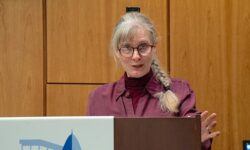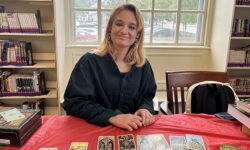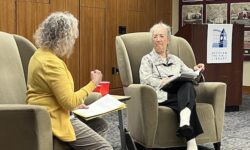[ccfic caption-text format="plaintext"]
By James Kinneen
Hometown Weekly Reporter
This year, the Needham Free Public Library’s summer reading program revolves around space exploration. So, last Tuesday, July 9, the Library invited NASA Solar System Ambassador Piyush Khopkar to speak about the red planet, Mars, and the science involved in exploring it.
While going to Mars is in so many science fiction movies, and both private space companies and NASA have talked about sending a man to walk on the surface, Khopkar began with a presentation showing how little people really know about the fourth planet from the sun.
For example, Khopkar asked the crowd if they knew the nickname for Mars, which most people, of course, did. However, when it came time to talk about why Mars is red and what it would actually look like if you were on its surface, the presentation revealed how much there was to learn.
Khopkar showed a bunch of images of the surface of Mars and pointed out how different the colors were. There were places on the planet that were golden, tan, and even greenish - but the soil of the planet has iron oxide in it, which kicks up into dust, resulting in the red coloring of the sky that creates the impression that the whole planet is red.
Another thing most people don’t know about the planet its volcanic history. Khohpkar noted that there’s actually a volcano on Mars called Olympus Mons, and it’s three times the size of Mt. Everest.
But Khopkar’s presentation was interactive as well.
To try and get the kids to understand that the Mars rovers move slowly because they are programmed using a set of specific commands - not remote controlled - Khopkar took a couple of chairs and placed them in the middle of the room. Next, he called up a child to walk the course and write down how many steps he should take before turning. Once this child’s commands were written, a group of children made a conga line, closed their eyes, and followed the instructions the person had outlined. Obviously, this was harder than it seemed, as the conga lines would break down due to differing walking speeds, the instructions being hard to follow, or a frustrated kid opening his eyes.
The highlight of the day was the 3D imaging. Khopkar had a couple photos of the surface of Mars that were blurry to the naked eye, but became three dimensional when viewed through the glasses he brought.
And as the kids examined the Lego rover he brought along, as well as collected their free NASA stickers and other souvenirs, Khopkar informed them they could be a huge part of space history. See, NASA is holding a contest to name the new rover for their 2020 mission - and it’s open to K-12 students. So if you have a good name idea and a good reason behind it, you could name the newest rover to go to Mars.
And if you saw Khopkar’s presentation, you’d know why that would be such a big deal.
























